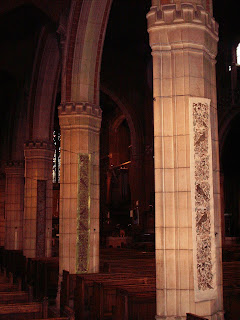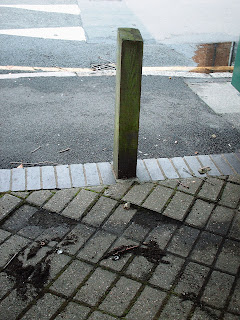Kirsten Schmidt, Creatures Great and Small, St Barnabas Church - detail
E17 Art Trail 2011.
In 1939, at least 2 significant public art works appeared in Walthamstow; J F Kavanagh’s 5 carved stone figures on the back of Walthamstow Town Hall, and (by another artist) the stained glass East Window at St Mary’s Church. The latter was removed for the duration of World War II; a wise decision considering the substantial bombing of the area, including the church.
Motherhood as a theme features figuratively in both those works of art. Anna Alcock and Kirsten Schmidt reflected this presence (perhaps unintentionally) of motherhood in their art work, Forest Guardians, exhibited in the ‘Inspired by Morris’ exhibition at William Morris Gallery in autumn 2010. In both sets of work one woman stands protectively over or by a child, while another holds an infant. The infant in the stained glass window is the baby Jesus. In Forest Guardians the infant held by the woman is a lamb.
What, if any, fantasy or mythology surrounds and imbues the maternal figures in these art works? David Mabb, another exhibitor in ‘Inspired by Morris’, gave a talk as part of the exhibition programme. He interpreted William Morris as a fantasist. Morris’s floral designs draw on an endless summer, fecundity and fruitfulness in medieval myth and legend. His affluent Victorian interior was a mis en scene for a quest for Avalon, Eden, and the Paradise garden. Kirsten Schmidt’s image of a woman holding a lamb is derived from a medieval German sculpture and the same image appears in a printed floral milieu in Creatures Great and Small - a set of 6 banners made for the columns of St Barnabas Church; a venue I took in on ‘my’ E17 Art Trail 2011.
Creatures Great and Small was a set of 6 printed banners. The printed designs consisted of intertwining floral patterns growing about a variety of animal and human figures. There were birds, a ram and the female/woman or chimera. Accompanying these symbolic creatures were streams of fish, Piscean in their upwards flow and meander through the trellis or undergrowth of assorted stems and leaves. Looking at the curving spiralling printed patterns drew my gaze upwards. Each banner followed a similar graphic scheme though each was also different in terms of the base fabric, the colours of the inks, and the order of the characters in the patterns. Each pattern appeared to be a variation on a theme - a play with the formal graphic design. I felt the lighter brighter prints on and against darker fabric (though still with a sheen) were more appealing and absorbing.
The columns were hard, stark and severe structures on and against which to hang the slightly diminutive banners. The precision of the column edges were in contrast to the soft unevenly undulating edges of the banners. The undulation accentuated the visual qualities of the printed surfaces however I felt there was also unwelcome visual discord by this. I wondered if the waviness was due to a difference in the bias of the printed fabric and the backing fabric. The discordance might have been less so had the banners been hung away from the columns rather than right against them, the weight of the banners hanging more freely.
What is the nature of Christianity’s relationship with crafts and craftsmanship and how could Kirsten Schmidt’s evocation represent not only some of the pleasure of this relationship but also tensions and paradoxes? Richard Sennett comments, ‘early Christianity had from its origins embraced the dignity of the craftsman’ doing work which ‘could counteract the human propensity for self destruction’. The appearance of peaceable and productive work could not completely affirm this conviction as the very materiality of the work brought or brings with it fear of the earthy temptress, Pandora. Kirsten Schmidt’s re-presentation of what might be an earth Mother Goddess (of pagan origin) inspired in part by William Morris also presents questions about how textiles has been used as a means of control of the female or feminine. Sennett comments on this prejudice in relation to Eve; it ‘bred a practice: female temptation could be countered by a particular craft, that of the needle, whether in weaving or embroidery, the woman’s hands kept ever busy’. Could Schmidt’s female figure be confined to needlework, in the way of Homer’s Penelope, unpicking by night all the needlework of the day in the service of an established kingship or patriarchal lineage?
Each banner might have been a verse in a hymn - a song to creation or creativity, an alternative to the hymn to Hephaestus - ‘every silk woven by swift fingers came from a loom your (his) burly hand designed’. Quite fantastically, a 5th century priest, Proclus, contrived a poem expressing the transmogrification of textiles materials - ‘the wool was the ancient fleece of Adam; the interlocking thread the spotless flesh of the Virgin’. The female figure on the banners may not be an origination of the Mother of God or Theotokos, however I would be surprised if her presence is not intended as some form of prompt as to questions about the complex theology of Mary, and more universally, myths of creation and origin a priori.
A specific place or host venue accentuates or alters the meaning of a creative work (visitor) - particularly the identity of that thing as a work of art and/or craft. It is pertinent to say a church is a place to contemplate origins and any object, with some gendered identity, placed in the church leads to statements about the origins and values of gender. To say something is a work of craft is to confer gender and this dialectic may lead to discussions about difficult transitions in gendered roles in the church establishment.
It is probably as well to return to the bannered space as one for personal fantasy. There I probably made a misidentification of one of the birds perched in the design of the banners however there is a genus of birds, Halcyon - kingfishers. Halcyon also has a mythical reference, that of a bird which makes a floating nest at sea. Their song is said to charm and calm the seas - a state of tranquillity for a journey to a place seemingly ‘way over yonder’; a gospel song in which Carole King (surely blessed by St. Blaise) sings, recalling Mabb’s and Morris’s Victorian Halcyon,
‘Way over yonder is the place I have seen,
In a garden of wisdom from some long ago dream,
And maybe tomorrow, I’ll find my way,
To the land where the honey runs in rivers each day,
And the sweet tasting good life is so easily found,
Yes it is’.
(Way Over Yonder, Tapestry. 1971)
Forest Guardians can be viewed here along with a statement by the artists.
Creatures Great and Small (detail), St Branabas Church. E17 Art Trail 2011.


















































